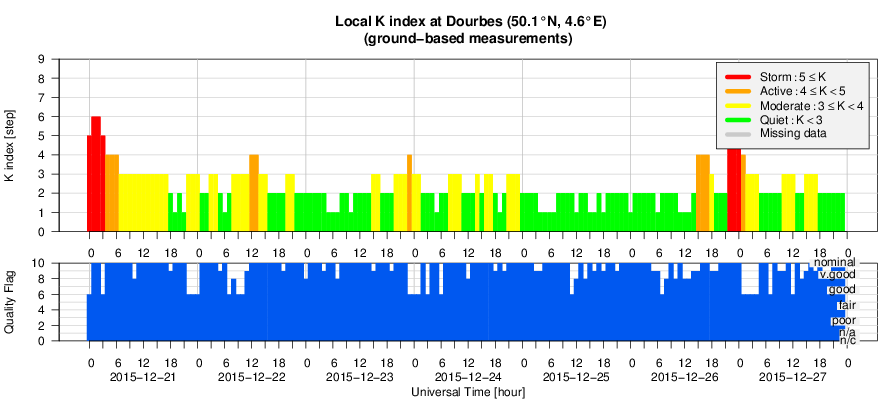- Table of Content
- 1.Review of sola...
- 2.Noticeable Sol...
- 3.Geomagnetic Ob...
- 4.Review of iono...
- 5.Future Events
2. Noticeable Solar Events (21 Dec 2015 - 27 Dec 2015)
3. Geomagnetic Observations at Dourbes (21 Dec 2015 - 27 Dec 2015)
4. Review of ionospheric activity (21 Dec 2015 - 27 Dec 2015)
5. Future Events
Review of solar and geomagnetic activity
Solar Activity
The flaring activity was dominated by two sunspot groups with Catania numbers 4 and 5 (NOAA ARs 2472 and 2473 respectively). They produced numerous C-flares and five M-class flares. The strongest flare was the M4.7 flare peaking at 00:40 UT on December 23 in the Catania sunspot group 5 (NOAA AR 2473). Activity decreased towards the end of the week especially from region 2472.
No Earth-directed CMEs were observed.
Geomagnetic Activity
The week started when the Earth was inside the trailing part of the ICME that arrived after the interplanetary shock detected on December 19. K index reached 5 as reported by Dourbes and Kp reached 6 as reported by NOAA. In the end of December 21 - beginning of December 22 the Earth entered the slow solar wind flow, and then the solar wind speed was steadily growing until it reached 600 km/s on December 26. By late December 26 a peak in solar wind velocity of around 640 km/s, associated with an extended period of negative Bz down to -6nT, caused an isolated period of minor geomagnetic storming. Apart from that the geomagnetic situation was mostly quiet to unsettled, with isolated intervals of active geomagnetic conditions (K = 4) reported by Dourbes and NOAA on December 22, 23 and 26.
Noticeable Solar Events (21 Dec 2015 - 27 Dec 2015)
| DAY | BEGIN | MAX | END | LOC | XRAY | OP | 10CM | TYPE | Cat | NOAA |
| 21 | 0052 | 0103 | 0111 | M2.8 | III/3V/2II/1 | 2472 | ||||
| 21 | 1009 | 1019 | 1032 | N4E85 | M1.1 | 1N | III/2 | 2472 | ||
| 22 | 0315 | 0334 | 0348 | S23E75 | M1.6 | SF | VI/2 | 5 | 2473 | |
| 23 | 0023 | 0040 | 0052 | S22E63 | M4.7 | 1F | II/2IV/2 | 5 | 2473 | |
| 24 | 0149 | 0212 | 0222 | M1.1 | 5 | 2473 |
| LOC: approximate heliographic location | TYPE: radio burst type |
| XRAY: X-ray flare class | Cat: Catania sunspot group number |
| OP: optical flare class | NOAA: NOAA active region number |
| 10CM: peak 10 cm radio flux |
Review of ionospheric activity (21 Dec 2015 - 27 Dec 2015)

The figure shows the time evolution of the Vertical Total Electron Content (VTEC) (in red) during the last week at three locations:
a) in the northern part of Europe(N61°, 5°E)
b) above Brussels(N50.5°, 4.5°E)
c) in the southern part of Europe(N36°, 5°E)
This figure also shows (in grey) the normal ionospheric behaviour expected based on the median VTEC from the 15 previous days.
The VTEC is expressed in TECu (with TECu=10^16 electrons per square meter) and is directly related to the signal propagation delay due to the ionosphere (in figure: delay on GPS L1 frequency).
The Sun's radiation ionizes the Earth's upper atmosphere, the ionosphere, located from about 60km to 1000km above the Earth's surface.The ionization process in the ionosphere produces ions and free electrons. These electrons perturb the propagation of the GNSS (Global Navigation Satellite System) signals by inducing a so-called ionospheric delay.
See http://stce.be/newsletter/GNSS_final.pdf for some more explanations ; for detailed information, see http://gnss.be/ionosphere_tutorial.php
Future Events
For more details, see http://www.spaceweather.eu/en/event/future
COSPAR/ILWS workshop: science for space weather in Goa, India
Start : 2016-01-24 - End : 2016-01-29
Understanding and being able to forecast space weather is an
increasingly important aspect of our modern technology-reliant
society. This workshop will treat all aspects of space weather,
ranging from solar origins of transient events (CMEs, Flares, CIRs)
to their propagation through the heliosphere and effects on Earth
and planetary bodies, from particle energization to forecasting
particle environment and its effects on technological and
biological systems, as well as solar-cycle effects and coupling of
space weather to atmospheric response. Metrics to assess
predictions will also be discussed. The workshop is structured
along the lines of the COSPAR space weather pathways and will
include invited, contributed talks and posters, as well as panel
discussions and tutorials.
Website:
http://www.cessi.in/ssw/program.html
The Scientific Foundation of Space Weather
Start : 2016-06-27 - End : 2016-07-01
Website:
http://www.issibern.ch/program/workshops.html
